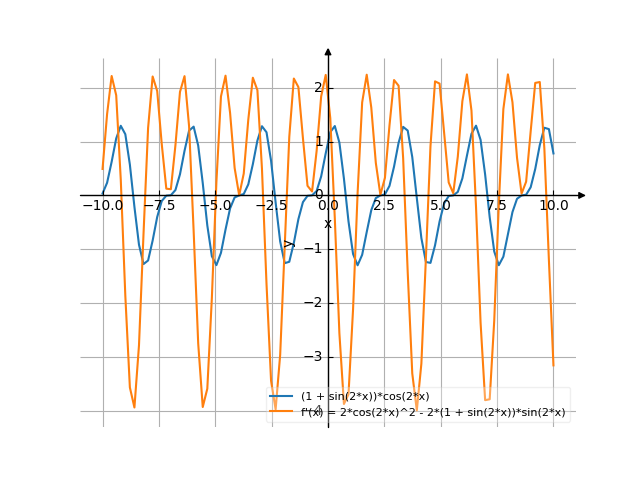Derivative of (1+sin(2x))*cos(2x)
The solution
You have entered
[src]
(1 + sin(2*x))*cos(2*x)
$$\left(\sin{\left(2 x \right)} + 1\right) \cos{\left(2 x \right)}$$
d --((1 + sin(2*x))*cos(2*x)) dx
$$\frac{d}{d x} \left(\sin{\left(2 x \right)} + 1\right) \cos{\left(2 x \right)}$$
Detail solution
-
Apply the product rule:
; to find :
-
Differentiate term by term:
-
The derivative of the constant is zero.
-
Let .
-
The derivative of sine is cosine:
-
-
Then, apply the chain rule. Multiply by :
-
The derivative of a constant times a function is the constant times the derivative of the function.
-
Apply the power rule: goes to
So, the result is:
-
The result of the chain rule is:
-
The result is:
-
; to find :
-
Let .
-
The derivative of cosine is negative sine:
-
Then, apply the chain rule. Multiply by :
-
The derivative of a constant times a function is the constant times the derivative of the function.
-
Apply the power rule: goes to
So, the result is:
-
The result of the chain rule is:
-
The result is:
The answer is:
The first derivative
[src]
2 2*cos (2*x) - 2*(1 + sin(2*x))*sin(2*x)
$$- 2 \left(\sin{\left(2 x \right)} + 1\right) \sin{\left(2 x \right)} + 2 \cos^{2}{\left(2 x \right)}$$
The second derivative
[src]
-4*(1 + 4*sin(2*x))*cos(2*x)
$$- 4 \cdot \left(4 \sin{\left(2 x \right)} + 1\right) \cos{\left(2 x \right)}$$
The third derivative
[src]
/ 2 2 \ 8*\- 4*cos (2*x) + 3*sin (2*x) + (1 + sin(2*x))*sin(2*x)/
$$8 \left(\left(\sin{\left(2 x \right)} + 1\right) \sin{\left(2 x \right)} + 3 \sin^{2}{\left(2 x \right)} - 4 \cos^{2}{\left(2 x \right)}\right)$$
The graph


![Find the derivative of y' = f'(x) = (1+sin(2x))*cos(2x) ((1 plus sinus of (2x)) multiply by co sinus of e of (2x)) - functions. Find the derivative of the function at the point. [THERE'S THE ANSWER!] (1+sin(2x))*cos(2x)](/media/krcore-image-pods/176/hash/derivative/0/8d/8095074b94d37a5c6a1581e7982d0.png)
 Derivative of x^cosx
Derivative of x^cosx
 Derivative of y=9
Derivative of y=9
 Derivative of y=7x+4
Derivative of y=7x+4
 Derivative of -x^3+4*x^2-4*x
Derivative of -x^3+4*x^2-4*x